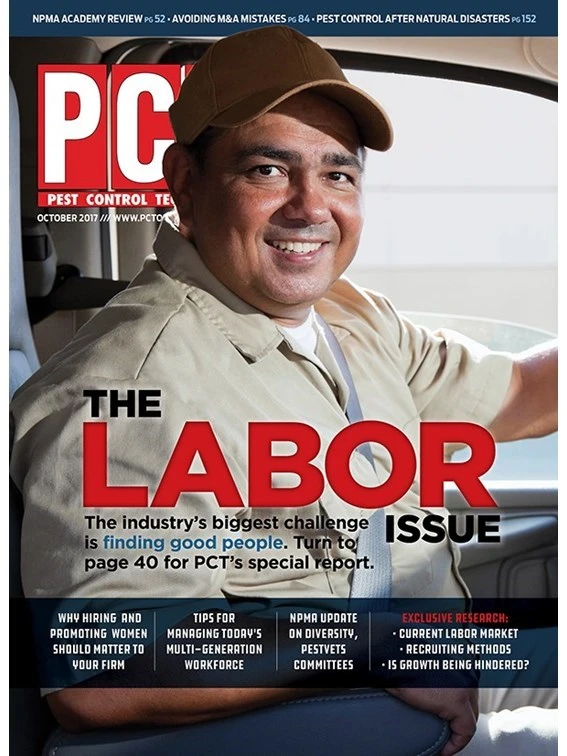
Finding and retaining good employees is a perennial challenge. Now pest management professionals face another: managing up to five different generations, each with its own belief systems and job requirements.
The largest group now employed is the millennial generation. They’re “definitely starting to have some effect” on the workplace, requesting “things we’ve never heard of” before like different types of vacation leave and flexible scheduling that “just boggles the mind” in light of current service models, said Laurie Higginbotham Wessinger, president of American Pest Control, Athens, Ga.
Generational differences are causing conflict, and the tension is having a detrimental effect on productivity and creativity, say many experts. But some of this conflict may have more to do with where employees are in their stage of development at a company, found a 2015 report by the HayGroup, a global human resources company.
Generation X and baby boomers put greater worth on innovation, global leadership and collaboration, while younger generations place more value on technical competence and decisive leadership. This reflects the typical pathway employees take as they progress in their careers, explained report author Tania Lennon, a human resources consultant who analyzed data from 5 million workers worldwide.
She also dispelled generational workplace myths. First, younger cohorts do not look to their leaders to provide meaning and purpose to their work; only employees older than 55 value this and millennials value it least of all, wrote Lennon.

Second, some research suggests younger generations are less loyal and more willing to change jobs; some pest management professionals have experienced this first hand. But the HayGroup report found all generations cite the same attribute as the primary reason for staying at their company: exciting and challenging work. That was followed by opportunities to advance and autonomy/freedom.
Third, leaders don’t need to manage employees of each generation differently; most employees want the same things from leaders. Instead, leaders should adapt their leadership styles to the needs of individuals and situations, Lennon said. Areas that can be worked on for greater workplace harmony and productivity, include:
AN OPEN ENVIRONMENT, Climates that embrace diversity and promote mutual understanding help overcome perceived generational differences. “Encouraging an environment where people can talk openly about their specific needs creates a workplace where everyone feels valued. This is more likely to come from dialogue than policy,” wrote Lennon.
Publicly recognizing employees’ contributions and making “sure that you show your appreciation for everyone” help build such a culture, said Kurt Scherzinger, general manager of Scherzinger Termite & Pest Control, Cincinnati. The company creates “a more social atmosphere” by holding cookouts several times a year where employees can get together without talking business, he said. Happy employees refer their friends, the company’s best source of new hires.
RANGE OF LEADERSHIP STYLES. Leaders who are best at engaging and motivating their teams — and who get higher performance as a result — draw on a broad range of styles. “Measure the range of styles your leaders use and help them to improve their impact” through training, Lennon said. ServiceMaster targets early career talent through its online university with leadership development and college internship programs.
THE PLUNGE. The high expectations that young generations bring to the workplace often drop off, which can lead many to seek opportunities elsewhere. To prevent this, develop onboarding and socialization programs to help young people establish themselves in their careers, wrote Lennon. This includes emotional and social skills they need to navigate the workplace, in addition to technical training.
Wessinger gives her management team the flexibility to shift in and out of different roles so they can follow their passions. “They’re so valuable I want them to stay. I don’t want them in a spot they’re miserable in” as they might leave, she explained.
ServiceMaster changed its hiring and recruiting practices to align more with the millennial mentality, said Cary McGuckin, senior director of digital marketing. It launched a refreshed employment brand and employee referral program and uses mobile-optimized video and social media to tell the story of real technicians, among other updates. The company expects to integrate more mobile, social, gamification and strategic search engine optimization with its job postings in the near future.
The author is a frequent contributor to PCT.

Explore the October 2017 Issue
Check out more from this issue and find your next story to read.
Latest from Pest Control Technology
- The Clendenin Anthony Partnership Adds Welch to M&A Group
- Three Ways to Control Mosquitoes
- Mapping Termite Movement
- Indiana PCO Wins Cicada Bobblehead
- Typhoon 3 Sprayer
- A&C Pest Management Wins Best of Long Island Award
- Certus Promotes Rezk to Chief Marketing Officer
- Forty-Seven Percent of PCOs Increased Mental Health Care Benefits, Poll Finds







